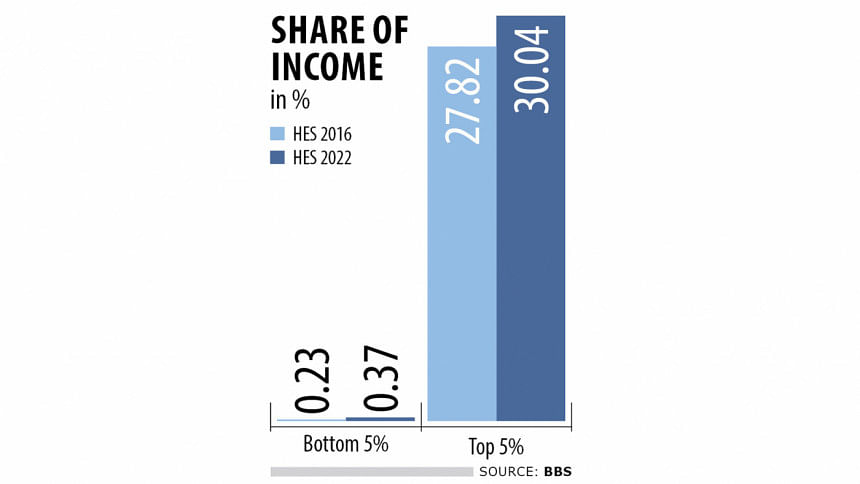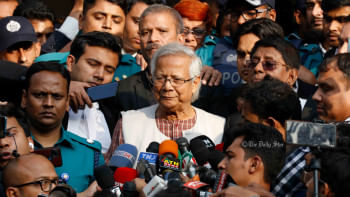Top 10pc have 40pc of income

As much as 40 percent of the country's total income is concentrated within the top 10 percent of the wealthy, up about three percentage points since 2016, found a recent government survey.
As much as 30.04 percent of the income generated in Bangladesh is concentrated within the top 5 percent of the households, up from 27.82 percent in 2016, according to the latest release of the "Household Income and Expenditure Survey (HIES) 2022" of the Bangladesh Bureau of Statistics.
Income concentration to the top 10 percent of the households is 40.92 percent. In 2016, it was 38.09 percent, according to the report that was released yesterday.
Besides, the income accruing to the bottom 5 percent of the households was 0.37 percent in 2022, which was 0.23 percent in 2016, adds the report.
The bottom 50 percent of the households have 19.05 percent of the total income, down from 20.23 percent in 2016.
According to the report, the Gini coefficient, which is the economic measure of equality, stood at 0.499 in 2022, in contrast to 0.482 in 2016. This means the country's income inequality increased between the two survey periods.
Inequality in society increased as irregularities in the banking sector, tax evasion and money laundering grew alarmingly, said Selim Raihan, executive director of the South Asian Network on Economic Modelling.
"The ruling Awami League yesterday in its election manifesto ahead of the January 7 polls pledged stern action against irregularities and corruption. It means this is the reality."
The wealth of many candidates increased enormously in a short period, which is surprising as well as indicative of why society faces inequality.
"Because of such irregularities and corruption, a large section of the society is deprived of the benefits of economic growth," said Raihan, also a professor at the University of Dhaka's economics department.
One reason behind increasing inequality amid economic growth could be the lack of job creation, said Hossain Zillur Rahman, executive chairman of the Power and Participation Research Centre, at the launch event for the report.
To reduce such inequality, reform initiatives and proper economic policies are required, Raihan said.
Although poverty declined between 2016 and 2022, the decline in poverty rate during the period was not as high as it was between 2010 and 2016.
In 2022, the poverty rate was 18.7 percent, down from 24.3 percent in 2016.
The rate of poverty reduction between 2016 and 2022 was 0.93 percentage points each year, according to the latest survey.
Between 2010 and 2016, poverty declined by 1.2 percentage points each year.
The latest BBS report shows poverty rate is highest in Barishal (26.9 percent) and remained almost stagnant (26.5 percent in 2016) among the eight divisions.
In the earlier survey, the highest poverty rate was found in the Rangpur division (47.2 percent) followed by Mymensingh (32.8 percent).
However, the latest survey shows the poverty rate in the two divisions has declined significantly and stood at 24.8 percent in Rangpur and 24.2 percent in Mymensingh.
In Chattogram, the poverty rate declined to 15.8 percent in 2022 from 18.4 percent in 2016.
In Khulna, the poverty rate stood at 14.8 percent in 2022. In 2016, it was 27.5 percent.
However, the poverty rate both in Dhaka and Sylhet divisions increased in the latest survey.
In Dhaka, the latest poverty rate is 17.9 percent, which was 16 percent in 2016. In Sylhet, the latest poverty rate is 17.4 percent, which was 16.2 percent in 2016.
One reason behind the increased poverty rate in Dhaka could be that many poor people migrated to the capital from elsewhere, Raihan said.
Also, the government's social safety net programme is mainly implemented in rural areas than urban areas while pandemic-induced economic shocks were more apparent in Dhaka, he added.

 For all latest news, follow The Daily Star's Google News channel.
For all latest news, follow The Daily Star's Google News channel. 




Comments